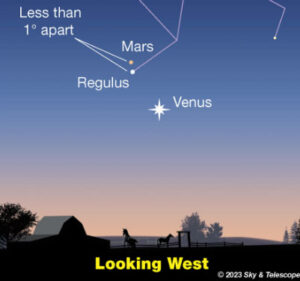Special to CosmicTribune.com, July 6, 2023
Excerpts from weekly Sky&Telescope report:
FRIDAY, JULY 7
■ Upper left of Venus in twilight, Mars is now less than 2° from Regulus. Regulus is magnitude 1.4, Mars is 1.7, meaning Mars is one-third fainter. Mars is closing in on Regulus; they’re now 1.7° apart. Their conjunction comes on July 9th and 10th.

SUNDAY, JULY 9
■ Mars and Regulus, upper left of Venus in late twilight, are in conjunction this evening and tomorrow evening, 0.7° apart.
■ Last-quarter Moon (exact at 9:48 p.m. EDT). The Moon rises around 1 a.m. By the beginning of dawn it’s high in the south, with bright Jupiter about two fists to its left and Saturn more than twice as far to its right.
MONDAY, JULY 10
■ The Moon, just past last quarter, rises around 1 a.m. tonight and Jupiter follows it up about 20 minutes later. By early dawn Tuesday morning they’re high in the east-southeast, with Jupiter to the Moon’s lower left.
TUESDAY, JULY 11
■ In early dawn on Wednesday, Jupiter shines upper right of the Moon. If it’s still dark enough, look for the Pleiades to the Moon’s lower left.
■ One hour after sunset, as twilight is fading and the stars are coming out, you’ll find the two brightest stars of summer, Vega and Arcturus, equally near the zenith: Vega toward the east, Arcturus toward the southwest (depending on your location).
 Different people have an easier or harder time seeing star colors, especially subtle ones. Vega is white with just a touch of icy blue. Arcturus is a yellow-orange giant. To me, their tints show a little better against the deep blue of late twilight rather than against the black of night.
Different people have an easier or harder time seeing star colors, especially subtle ones. Vega is white with just a touch of icy blue. Arcturus is a yellow-orange giant. To me, their tints show a little better against the deep blue of late twilight rather than against the black of night.
THURSDAY, JULY 13
■ Starry Scorpius is sometimes called “the Orion of Summer” — for its brightness, its blue-white giant stars, and its prominent red supergiant (Antares in the case of Scorpius, Betelgeuse for Orion). But Scorpius passes a lot lower across the southern sky than Orion does, for those of us at mid-northern latitudes. That means it has only one really good evening month: July.
Catch Scorpius at its highest in early to mid evening now, before it starts to tilt lower toward the southwest. It’s full of deep-sky objects to hunt with binoculars or a telescope and a sky atlas.
FRIDAY, JULY 14
■ After dark Altair shines in the east-southeast. It’s the second-brightest star on the eastern side of the sky, after Vega high to its upper left. The third star of the Summer Triangle is Deneb, less bright, to their left.

You must be logged in to post a comment Login